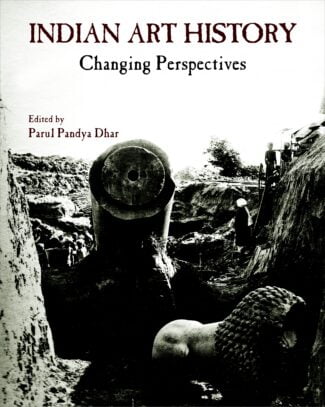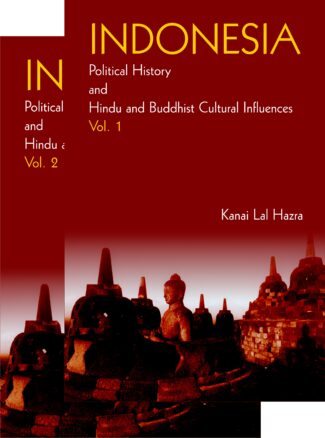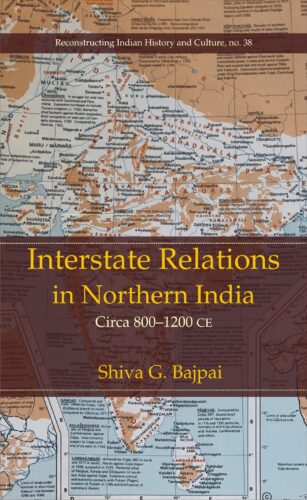Showing 71–80 of 196 results

History Today is a journal devoted to History, Historical Archaeology, Studies of Manuscripts, Education, Literature, Linguistics, etc. The present volume is a reprint of an earlier issue containing ten articles written by eminent historians and art lovers.
History Today is an official organ of the Indian History and Culture Society that is sincerely and single-mindedly devoted to history, historical archaeology, studies of manuscripts, education, literature, linguistics, etc.
The present volume, being a reprint of an earlier issue, contains eight articles written by eminent historians and art lovers. The subjects vary from Pattern of Urban Growth in northern India; shifting contours of Temple Patronage in Rajasthan; Tawaif and Khawas in erstwhile Hyderabad State; Islam and Islamic Iconoclasm in India; Prof. Habibs reaction to ASIs Report on Ayodhya; a critique of Habibs reaction; Rejection of Caste Inequalities by the Sikh Gurus; and use of Plastering Materials in Ancient India. The volume also carries Notes, News and New Source Material on the above topics.
The annual History Today journal has already published eight issues consecutively and has received high acclaim among historians, researchers and students.

History Today is a journal devoted to History, Historical Archaeology, Studies of Manuscripts, Education, Literature, Linguistics, etc. The present volume is a reprint of an earlier issue containing ten articles written by eminent historians and art lovers.
History Today is an official organ of the Indian History and Culture Society that is sincerely and single-mindedly devoted to history, historical archaeology, studies of manuscripts, education, literature, linguistics, etc.
The present volume, being a reprint of an earlier issue, contains eight articles written by eminent historians and art lovers. The subjects vary from Pattern of Urban Growth in northern India; shifting contours of Temple Patronage in Rajasthan; Tawaif and Khawas in erstwhile Hyderabad State; Islam and Islamic Iconoclasm in India; Prof. Habibs reaction to ASIs Report on Ayodhya; a critique of Habibs reaction; Rejection of Caste Inequalities by the Sikh Gurus; and use of Plastering Materials in Ancient India. The volume also carries Notes, News and New Source Material on the above topics.
The annual History Today journal has already published eight issues consecutively and has received high acclaim among historians, researchers and students.

History Today is an official organ of the Indian History and Culture Society that is sincerely and single-mindedly devoted to history, historical archaeology, studies of manuscripts, education, literature, linguistics, etc.
The present volume, being a reprint of an earlier issue, contains eight articles written by eminent historians and art lovers. The subjects vary from Pattern of Urban Growth in northern India; shifting contours of Temple Patronage in Rajasthan; Tawaif and Khawas in erstwhile Hyderabad State; Islam and Islamic Iconoclasm in India; Prof. Habibs reaction to ASIs Report on Ayodhya; a critique of Habibs reaction; Rejection of Caste Inequalities by the Sikh Gurus; and use of Plastering Materials in Ancient India. The volume also carries Notes, News and New Source Material on the above topics.
The annual History Today journal has already published eight issues consecutively and has received high acclaim among historians, researchers and students.
History Today is an official organ of the Indian History and Culture Society that is sincerely and single-mindedly devoted to history, historical archaeology, studies of manuscripts, education, literature, linguistics, etc.
The present volume, being a reprint of an earlier issue, contains eight articles written by eminent historians and art lovers. The subjects vary from Pattern of Urban Growth in northern India; shifting contours of Temple Patronage in Rajasthan; Tawaif and Khawas in erstwhile Hyderabad State; Islam and Islamic Iconoclasm in India; Prof. Habibs reaction to ASIs Report on Ayodhya; a critique of Habibs reaction; Rejection of Caste Inequalities by the Sikh Gurus; and use of Plastering Materials in Ancient India. The volume also carries Notes, News and New Source Material on the above topics.
The annual History Today journal has already published eight issues consecutively and has received high acclaim among historians, researchers and students.

History Today is an official organ of the Indian History and Culture Society that is sincerely and single-mindedly devoted to history, historical archaeology, studies of manuscripts, education, literature, linguistics, etc.
The present volume, being a reprint of an earlier issue, contains eight articles written by eminent historians and art lovers. The subjects vary from Pattern of Urban Growth in northern India; shifting contours of Temple Patronage in Rajasthan; Tawaif and Khawas in erstwhile Hyderabad State; Islam and Islamic Iconoclasm in India; Prof. Habibs reaction to ASIs Report on Ayodhya; a critique of Habibs reaction; Rejection of Caste Inequalities by the Sikh Gurus; and use of Plastering Materials in Ancient India. The volume also carries Notes, News and New Source Material on the above topics.
The annual History Today journal has already published eight issues consecutively and has received high acclaim among historians, researchers and students.
History Today is an official organ of the Indian History and Culture Society that is sincerely and single-mindedly devoted to history, historical archaeology, studies of manuscripts, education, literature, linguistics, etc.
The present volume, being a reprint of an earlier issue, contains eight articles written by eminent historians and art lovers. The subjects vary from Pattern of Urban Growth in northern India; shifting contours of Temple Patronage in Rajasthan; Tawaif and Khawas in erstwhile Hyderabad State; Islam and Islamic Iconoclasm in India; Prof. Habibs reaction to ASIs Report on Ayodhya; a critique of Habibs reaction; Rejection of Caste Inequalities by the Sikh Gurus; and use of Plastering Materials in Ancient India. The volume also carries Notes, News and New Source Material on the above topics.
The annual History Today journal has already published eight issues consecutively and has received high acclaim among historians, researchers and students.

Dr. Bhargavas book opens a fascinating panorama of life in Vedic India, highlighting in particular, its powerful dynastic families, its rsis, society, economic conditions, political set-up, religion, philosophy and literature. The book includes a vivid description of the Aryan homeland, its geography, flora and fauna and a lot else.
Vedas arent just the scriptural texts, but the earliest record of Indo, Aryan civilisation. On the basis of this corpus of mankinds oldest literature, together with his indepth analyses of the later-day Puranic writings, Professor Bhargava offers the first ever systematic, well-knit study of the Aryan expansion on the Indian subcontinent since c. 3100 bc. Retrieving, thus, hard historical facts from the complex Sanskrit verses of ancient seers, Dr. Bhargavas book opens a fascinating panorama of life in Vedic Indiahighlighting, in particular, its powerful dynastic families, its rishis, society, economic conditions, political setup; religion, philosophy and literature. The book also includes a vivid description of the Aryan homeland, its geography, flora, fauna, and a lot else. Now in its third enlarged, fully revrsed and updated edition; India in the Vedic Age has, ever since its first appearance in 1956, been acclaimed not only by prestigious journals or discerning readers, but also by many IndologistsISanskrit historians of worldwide eminence, including notably, A.L. Basham, K.D. Vajpeyi, Ludwik Stembach, T.G. Mainkar, and G.V. Devas. While A.S. Altekar acknowledged it as a distinct advance over Pargiters work, Dr. Bhargavas book is certainly, as U.N. Ghoshal observed, the most original work of our time.

The key art historical concerns addressed in this volume include studies in form, style, textual interpretations, iconography, symbolism, representation, connoisseurship, artists, patrons, gendered readings, and the inter-relationships of art history with archaeology, visual archives, and history, in the Indian context.
The shaping of the disciplinary practice of art history in the Indian context has been a fascinating process and brings to the fore a range of viewpoints, issues, debates, and methods. Changing perspectives and approaches in academic writings on the visual arts of ancient and medieval India form the focus of this collection of insightful essays.
A critical introduction to the historiography of Indian art sets the stage for and contextualizes the different scholarly contributions on the circumstances, individuals, initiatives, and methods that have determined the course of Indian art history from colonial times to the present. The spectrum of key art historical concerns addressed in this volume include studies in form, style, textual interpretations, iconography, symbolism, representation, connoisseurship, artists, patrons, gendered readings, and the inter-relationships of art history with archaeology, visual archives, and history.
Based on the papers presented at a Seminar, Historiography of Indian Art: Emergent Methodological Concerns, organized by the National Museum Institute, New Delhi, this book is enriched by the contributions of some scholars who have played a seminal role in establishing art historys disciplinary orientations in the Indian context, and by those who offer more recent perspectives on the subject. Lucid and informative, this is an indispensable resource for all those engaged with the history and historiography of ancient and medieval Indian art in universities and museums across the globe, and will also be of interest to the general reader.

The two volumes present a comprehensive study of political, cultural and religious history of Indonesia. Of encyclopaedic significance, they take up a whole gamut of themes relating to history, politics, religion, literature, art and architecture, and sculpture of Indonesia. The volumes will immensely benefit scholars of political history, religion and culture specialising in South-east Asia and its links with other regions of Asia.
The two volumes present a comprehensive study of political, cultural and religious history of Indonesia. Of encyclopaedic significance, they take up a whole gamut of themes relating to history, politics, religion, literature, art and architecture, and sculpture of Indonesia. The first volume is on political history of Indonesia. It covers all dynasties/rulers of Indonesia from the earliest Sailendras of Srivijaya to the political scene in current times including the rise of President Sukarnoputri in the recent past. It covers a very wide range of aspects: struggles of dynasties, establishment of empires by the Sailendras, the Indo-Javanese empire of the kingdoms of Mataram, Kadiri, Singhasari and others, emergence of new cultures, decline and fall of the Hindu kingdom, colonial invasions and growth of nationalism. The second volume begins with the history of East Timor. It makes an in-depth survey of Hinduism, Buddhism and Islam in Indonesia, covering their establishment, contacts with other places owing to their religious links, modes of religious worship and rituals. The art, architecture and sculpture of the country symbolising Hindu, Buddhist and Islamic traditions are surveyed meticulously. A detailed account of Indonesia’s literature involves study of writers and their works, and languages and characteristics of the literature at various times. The volume discusses chronicles, historical writings, writings on medicine and on numerous miscellaneous topics, throwing light on their contents and styles of expression. The volumes will immensely benefit scholars of political history, religion and culture specialising in South-east Asia and its links with other regions of Asia.

Interstate Relations in Northern India (8001200 ce) is a critical analysis of the Empire and State, the RÀja-Maõçala, in medieval India. The book is an excellent interpretation of the composition of the state, the ancient Indian principles and categories of interstate relations dealing with rÀjya and maõçala (circle of states).
This thoroughly researched work examines the state and its seven constituent elements (rÀjya). While avoiding the temptation of using Western categories and principles of international law, it provides an explanation of classification of states based on power, independence, tribute and political allegiance. In particular, it defines and analyses the ÈÀçguõya (sixfold policy of sandhi (peace), vigraha (war), yana (marching), Àsana (staying quite), dvaidhÁ-bhÀva (dual policy) and saÚraya (seeking shelter thereby correcting earlier misconceptions)). Furthermore, the theoretical formulations of circle of states and interstate relations between (8001200 ce) have been placed in a historical context, and well attested by historical instances in north India. Based on geopolitics and power it demonstrates the impact of political thought on political expedients, stratagems and events, at a crucial time in Indian history. The influence of ideas on political behaviour of kings and trajectories and policies of kingdoms of the Candellas, PÀlas, ParamÀras, PratihÀras, RÀjpÂts, CÀÒukyas, RÀÈÇrakÂÇas, Arabs and CÀhamÀnas have been substantiated with facts and evidences.
The author, Dr Shiva Gopal Bajpai, is to be congratulated for providing an accurate analysis of ancient Indian political theory and interpretation of its practical application by medieval rÀjÀs, thereby making a significant contribution to our understanding of Indian history.
The book thus delves deep into the philosophies of both Bdaryaa and akara in enunciating the essential features of Brahman and Its association with the world. It thus discusses topics such as what sort of cause Brahman is?, and what sort of material causality is to be ascribed to It? It also addresses the conflicting views on the nature of Brahman like that of Vivarttavda and of Rmnuja’s Sagua-Brahman.

History of Jainism has been divided into three parts Jain history and its origin; its historic importance; and Jain religion during the interim periods all covered in detail. Jainism during Mogul rule its Social and Economic condition, has also been described.
History of Jainism has been presented here in three parts. The first part tries to prove through the archaeological and literary sources the historicity of Tirthamkara, Parsvanatha and Mahavira, explaining their life and education besides religious, political, social, artistic and literary conditions of their times. The second part surveys the history of the Jaina dharma, its expansion and significance. The effects of Jaina dharma increased when Mauryas were ruling Magadha and Kharawelas ruled Orissa. No doubt, the period from the 9th to 12th centuries ce was a golden time in the history of Jainism and even traders, labourers and craftsmen were highly influenced by it during Kusana period. Seen geographically, Cauhana, Paramara and Calukya were acting as watchmen for Jainism in the north and in the south it was being nourished by Calukya, Rastrakuta and Ganga (Kingdoms). Many Jaina temples were constructed, monuments erected in honour of their deities. This part illustrates the many ways in which Jainism was served by the Jaina monks, saints, scholars and the politicians and answers questions such as: What kind of religious and social unions were made after the division and what were their traditional characteristics? How were the different leagues and monastries of Jaina sages made? What was the lineage of various castes and how they originated? The third part, associated with the middle ages of Jainism, describes that even though there was Muslim rule, still many organizations were sponsored with the influence of Jainism. Truthfully, there was a decline in Jainism during the middle ages but it remained protected. Many pilgrimages and historical places were established with the great influence of Jainism. Dr A.H. Nizami has written here about the Muslim reign, conditions of Jainism and also about the admirable Jainas. Dr Surendra Gopal has described the social and financial conditions prevailing at this period. Dr Shyam Sunder Nigam has penned on the middle ages of India and Dr Prakash Chandra Jain has written about the Jaina religion in the Middle Ages in Malwa region. This monumental work will be a treat for the minds and eyes of people curious about Jainism.
| There are no products |